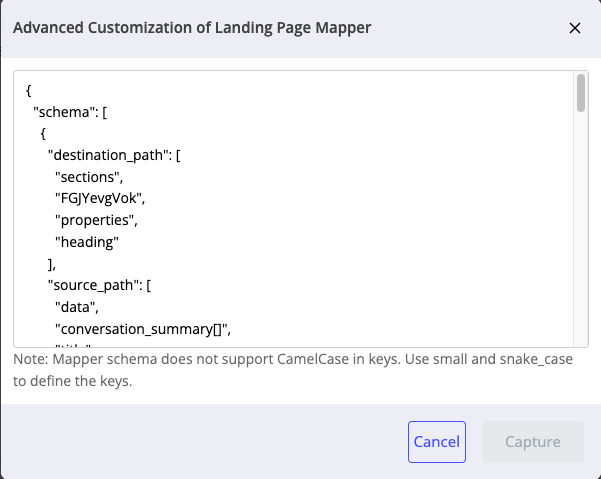You can set or update the basic settings for your agent in the ChatFactory Agent Config interface. The key configuration options available in the Agent Config tab are described below.

General Settings
These are the basic settings required for the agent to operate and function properly.
Agent Name: Update the unique name of your ChatFactory agent (e.g., “marketing”). Access to the agent will be defined by the name provided here, e.g. <your company domain>/aichat/marketing. This name helps distinguish between different agents in your organization
Description: Provide a brief description of the agent’s purpose and usage
External Codes: These are snippets of HTML or Javascript code in the PathFactory External Code Library that are inserted into your agent page. Such code is often used to update certain text, images or behavior that are not accessible via configuration. You can do the following:
- Exclude External Codes: Remove external code that is being injected into the page from elsewhere, e.g. Google Tag Manager.
- External Code: Add specific external code that is used to update something on the agent page.
Conversation Collection: Update the collection that the agent will use to answer questions
Recommend Collection: Update the collection that the agent will use to recommend content to users
Landing Page Configuration
The landing page is the page that is shown to the end user when they choose to create an experience based on their interactions with the ChatFactory agent.
Create Experience: Enable the creation of an experience as part of the ChatFactory agent interaction. If this toggle is turned off, certain options in Theme Settings will become unavailable.
Landing Page: Select the landing page that will be used to create the experience
Section to insert summary: Select the section where the conversation summary will be displayed. This is typically a hero section.
Section to insert user selected content: Select the section where the user selected content will be displayed. This should be a content playlist section.
Advanced Customization: This link opens the Advanced Customization window where you can add your own code to insert summaries and user content, especially in custom sections.

Experience Strategy
You can decide additional conditions to surface the experience creation option to users. For example, you can decide to only let users who have asked a certain number of questions create experiences. This will ensure that there is sufficient conversation to generate a meaningful summary that can be included in the experience.
Minimum Conversion Count: Set the minimum number of conversations required before triggering experience-based actions
Automatic Experience Delivery: The toggle to send experiences to known users automatically at the end of a session allows you to decide whether the experience creation is user driven or system driven.
External Code: If the automatic experience delivery toggle is turned on, you will need to provide external code that will trigger the email followup using your preferred provider (e.g. Marketo, Eloqua).

Form Strategy
The form strategy section lets you determine when forms are surfaced to users to enable conversions. Options are:
Show Form: Toggle whether to display forms to users when interacting with the agent
Form Selection: Choose from available forms in the PathFactory form library
Customize Title and Description: This toggle lets you override the title and description of the form. This only applies to PathFactory forms and not to forms from a MAP like Marketo or Eloqua.
Display Behavior
This section lets you decide when the form is surface to the user. Options are:
Form On Load: Display the form immediately when the agent loads
Form On Exit: Show the form when users leave the agent. This mode works best when your users use full-page agents rather than the chat form factor.
Form On Experience Creation: Present the form when the user creates an experience
After Spending Time (minutes): Show the form after users have been engaged for a specific duration
After Number Of Queries: Display the form after a specific number of user questions
Form Behavior
This section lets you define other behaviors of the form. Options are:
Show to unknown visitors: Display forms to new or unidentified users
Show to known visitors: Present forms to returning users
If submitted, allow form to show again: Control whether forms should be displayed to the user even after they convert
Allow visitors to dismiss form: Enable users to close or dismiss forms and continue using the agent
Customize Options
These options allow you to further configure the end user interaction with the agent.
Preview in Modal Mobile: When opening a content recommendation from a mobile device, show the preview in a modal instead of a new tab.
Preview in Modal: When opening a content recommendation from a desktop, show the preview in a modal instead of a new tab.
Featured Content Preview Mode: Define how recommended content is displayed. Options are to display the asset as part of a content playlist or as a standalone asset.
Score Based Tags: Display tags on recommended content based on match score using JSON
- Example: {“label”:”Best Match”,”maxRange”:1,”minRange”:0.7,”textColor”:”#FFFFFF”,”backgroundColor”:”#FFB500″}
History Filter: Configure the display of conversation history using JSON
- Example: [{“section”:”0d”,”displayName”:”Today”},{“section”:”-1d”,”displayName”:”Yesterday”},{“section”:”-1w”,”displayName”:”Last 7 days”},{“section”:”-1m”,”displayName”:”Last month”}]
Max Bookmarks Allowed: Limit how many assets users can add to their library
Stream the response: Display responses from the agent as a real-time conversation flow
Message for unknown responses: Provide fallback messages when the agent cannot answer a question
This configuration system allows for extensive customization of your ChatFactory agent to match your specific business needs and user experience requirements.
Views: 15
